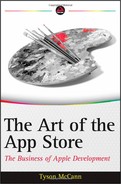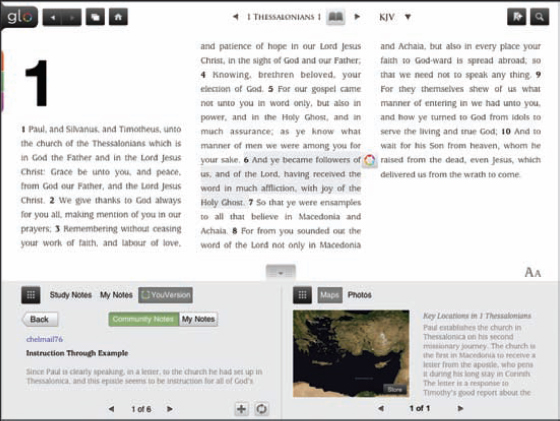PROVIDING THE TOOLS FOR USERS TO CONNECT
This section goes into detail about how to drive virality and social engagement from within and outside of your app. One of the easiest ways to accomplish this is with Facebook Connect and a few lines of code. Note also that Twitter functionality is currently in the midst of a large overhaul in the way Apple handles it in iOS 5, which is examined in more detail next.
Implementing Facebook Connect and Twitter
Facebook Connect allows you to draw from the hundreds of millions of other Facebook users to connect and compete with your friends. It doesn't have the same type of functionality as a dedicated networking platform such as OpenFeint with forums and achievements and the like, but it is a must-have for adding another viral channel to your promotion campaign.
The best way to implement Facebook functionality is using the Facebook Connect API (http://developers.facebook.com/docs/guides/mobile/). This is essentially the injection of C code into your existing Xcode project that utilizes the Facebook API to access user profiles and share information back on Facebook.
For Twitter, in iOS 5, Apple now integrates directly and natively with the device, allowing any app to be able to tweet events or achievements. With this sort of functionality, it will be important to consider adding Twitter as another share mechanism, just as Facebook traditionally has been.
Let's look at a couple of examples of the ways Facebook Connect has been utilized in games and apps.
“Zynga Poker” exclusively uses Facebook Connect for multiplayer features and chat. Note the locked icons in Figure 10-17, representing all of the things you cannot do unless you log in to Facebook.
Similarly, note how the entire game changes once logged in to Facebook, as shown in Figure 10-18. Of course, the developers purposely de-emphasized the nature of the photographs when not logged in to Facebook as an incentive to sign in (and other notifications and touches in the same vein abound). But, nevertheless, the game is built to be played with friends and on a social network.
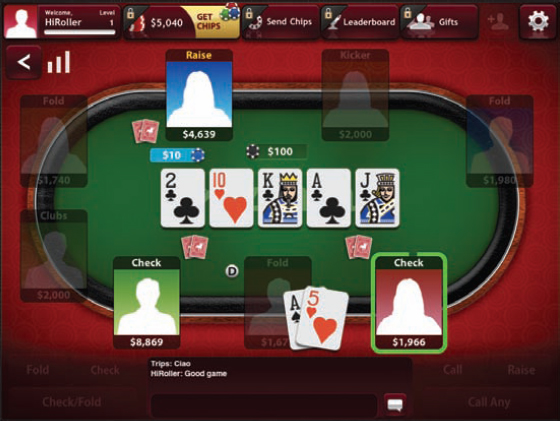
FIGURE 10-17: “Zynga Poker” relies heavily on Facebook for its multiplayer and user engagement
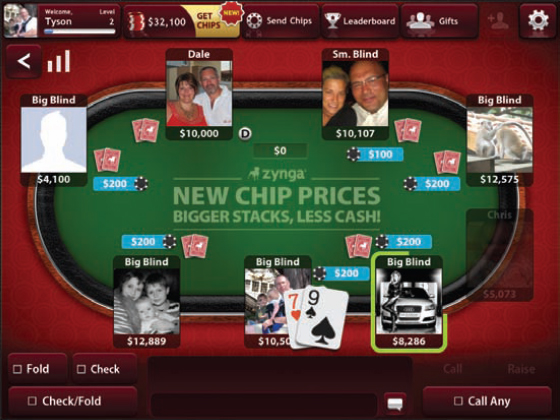
FIGURE 10-18: The entire game dynamic in “Zynga Poker” changes when you can see your friends, and even play with strangers as in real life
An example of an app and not a game is demonstrated in how Amazon's Kindle app functions. As shown in Figure 10-19, it uses both Twitter and Facebook Connect to be able to share excerpts to your Twitter feed and Facebook wall. In Kindle options, users are able to log in to both of the networks.

FIGURE 10-19: The popular free Kindle app allows users to share excerpts of books to Twitter or Facebook
In the next section, you learn some techniques developers use for maintaining a social community within the app.
Fostering Your In-App User Community
When users of an app can share and receive information, or communicate with one another while using it, it increases both engagement with your app, and, because people are always full of surprises, encourages users to come back (retention). Here are some examples of how this can be accomplished:
- Integration with a specialized network — For example, YouVersion (www.youversion.com) is an extensive social network centered around those who study the Bible, and is tightly integrated with a highly polished Bible study app named “Glo Bible” (shown in Figure 10-20). When logged in, users can see the comments of others, and write and share their own notes for virtually any facet of the lengthy tome.
- Use OpenFeint or Facebook to chat and more — With Facebook, developers can set up chat for friends, and OpenFeint features chat and forums across all apps, and even cross-platform.
- Use leaderboards and achievements — As mentioned earlier in this chapter, both of these can help foster a sense of community.
- Provide support from within-app — Allow users to e-mail you with feedback or questions without needing to exit the app, or at least route them easily to your website's support page.
FIGURE 10-20: The “Glo Bible” app integrates with YouVersion, a social network based around study of the Bible
Maximizing Viral Channels
Though this book isn't designed to go into too much in-depth detail concerning social marketing, some overall tips will help accelerate your online presence and help propel your viral growth. Aside from advertising campaigns, the main ways to do this are within your app (discussed earlier in this section), and externally via the Facebook Fan Page, Twitter feed, and YouTube videos. These last three should be a part of every new app marketing campaign (at least until something better comes along).
Facebook Fan Page
Facebook Fan Pages can have millions of fans (those who “like” it), come up frequently near the top of Google searches for various brands, and are excellent ways for users to interact with your brand without going to a separate brand website (as shown in Figure 10-21). The goal for a Fan Page is to provide information to users interested in your brand, thus keeping them continuously engaged. You typically do this by updating it frequently with the latest news about your product or brand.
When a user comes to your page and “likes” it (via the Like button), a notification is placed on his or her wall where other users can see it, thus starting the viral loop. Furthermore, additional content that you post and promote will also appear on their pages. Therefore, your end goal is to get users to “like” your page so that their friends will see their endorsement.
Fan Pages consist of a “landing tab” (which can be configured and will be where users first find themselves, thus making it imperative that this is as engaging and branded toward your app as possible), a wall (where news and user comments can be found that should be updated frequently, along with any other number of sub tabs/pages, including support, contests, quizzes, downloads, and specific information), and interactable pages about different aspects of your app or brand. Finally (and importantly), you can have fan-only content that can be locked until they “like” the page.

FIGURE 10-21: The Coca-Cola Fan Page, the largest on Facebook, was created literally by fans, and has the company's endorsement
There is an art to creating a Facebook Fan Page, and Internet articles abound on how best to achieve it. The following top tips are formed from a combination of the author's research, in addition to the best techniques gleaned from such articles, in no particular order of importance (except for the top recommendation):
- Use Facebook apps to enhance your Fan Page — This is critical, and cannot be stressed enough. Don't just settle for the default setup. Zillions of add-on apps have been built for the purpose of adding interactivity and helping promote your page. Fortunately, there are also quite a few blog articles that focus on filtering out the best of them, such as an excellent one at www.socialmediaexaminer.com/facebook-apps/.
- Auto-post your selected Twitter feeds for wall content — Apps can help with this, such as the appropriately named Selective Tweets, so that you aren't spamming unrelated information. See www.facebook.com/selectivetwitter for more information.
- Have a branded landing tab — This is another critical element to any Fan Page. In fact, it was reported that the founder of BrandedGlue, Jeff Widman, performed split tests with his company on conversion to fans with and without a landing tab, and found that having a landing tab doubled conversion rates (from 23 percent to 47 percent).
- Import your blog's RSS feed for additional content — A good app to help with this is Networked Blogs at www.facebook.com/networkedblogs.
- Incentivize users to become fans — Offer unlockable content such as downloads, wallpapers, exclusive content, coupons, discounts, or other promotions to entice users to become fans via the Like button. Many pages add a large graphic arrow that literally points to the Like button along with the offer. Victoria's Secret has on its wall an exclusive tab for fans.
- Consider your fans and what is important to them — This is common sense, but if you over-promote, you run the risk of losing retention. Fans can and will “unlike” your page because of the spam it can post on their own pages.
- Ask for feedback to gain loyalty — If you are willing to support your app post-release, this can be a great way to gain “street cred” with your fans, because it shows you are a developer/brand who listens and attempts to make it better. Don't forget to take some action on feedback.
- Promote real-world events — This can bridge the gap between online and off.
- Funnel fans to your Facebook Fan Page throughout your marketing — This can be through e-mail newsletters, your brand site, blog, anywhere you can link to your Fan Page to increase conversion into fans.
- Hold contests and incentivize with rewards — The bigger the reward, the more shareable the app becomes throughout social circles.
- Pay for fans — There are sites in which you can “buy” fans in bulk and fairly cheaply. This can be a good way to kick-start your Fan Page.
- Make use of large profile photos — Don't just use the square photo. Develop something larger and more prominent. The 200 × 600 pixels they provide offers a lot of flexibility.
- Update frequently — Fans will leave if you don't keep your content fresh and frequent. Just how frequent is subject to debate, but once per day to start should be sufficient. You'll eventually want to balance your own posts with those of users, once they start becoming engaged. Remember to keep new information unique and not repost anything twice.
With these tips, you should be able to create (or update) a fantastic Fan Page capable of good conversion rates for your brand. Next up is Twitter.
Another large social network with great viral potential is Twitter. Users tend to tweet much more often than they post on their Facebook wall, and with the invention of “re-tweeting” what other users have already tweeted (sort of like forwarding an e-mail to everyone on your contact list), there is a huge potential to get more attention for popular tweets.
Every app or brand should also have a corresponding Twitter feed to reach the most people, and funnel them into your brand's online presence to also include the Facebook Fan Page. Here are some of the best tips for getting more Twitter followers, and maintaining an effective feed for your brand:
- Offer special codes, coupons, or gifts only to Twitter followers — In the earlier section, “Gifting with Virtual Objects, Free Stuff,” the Dell Outlet example was used. This can be a powerful method to incentivize users to become followers.
- Shorten and track tweet links with Bitly — Bitly (www.bit.ly) is a popular link shortener that can turn any link into a manageable length in order to be able to insert it into your 140-character-limit tweets (or anywhere a link is required). Not only that, it provides detailed tracking of click information for each link, including how many times a particular link was clicked. Another popular link shortener is TinyURL (www.tinyurl.com), though it doesn't offer the same type of tracking that Bitly does. Metrics are your way to iterate on success.
- Follow those people who are relevant to your brand — People take a look at who you are following, and you will lose credibility if you follow anyone and everyone, which brings up the next point.
- Don't follow more people than you have followers — It's counter-productive to seem like you've followed 10,000 people and only have 2,000 followers. Fewer people will follow you if your follow ratio is too high.
- Use hashtags — A hashtag is a more recent and community-driven evolution of Twitter functionality, where you can insert a number sign (#) in front of keywords so that Twitter can make use of the word itself as metadata in searches. To opt-in, you follow @hashtags.
- Buy Twitter followers — Just as you can buy Facebook fans, you can do the same with Twitter. Remember, this will be part of your user acquisition cost (UAC).
- Tweet relevant and varied information to your users — Don't go all out with sales promotions. Ration them to about one-third general info about your brand, one-third relevant info about your industry/app, and one-third sales promotions or marketing.
- Sales and marketing info can include codes, specials, contests, events, or promotion date information.
- Brand info includes uploading new app pics (www.twitpic.com), staff information, support information, customer/client news, and product tips.
- Industry info includes news, questions (start conversations), asking for suggestions, and re-tweeting information.
- Do a little competitive research — Find out what others in your niche are tweeting about, and strive to match or do better for your followers.
- Optimize Twitter bio content — This is indexed in search engines, so optimize for keywords (use the Google keyword search tool — search google.com for “Google keyword search tool”).
- Add Twitter links to your brand website — This will funnel potential followers to your feed.
- Add your brand's URL to Twitter — Cross-referencing your Twitter with your brand page (and vice versa) will result in more traffic to both.
- Optimize your tweets for keywords — Use the Google keyword tool mentioned earlier when possible to optimize searchability for your tweets. This is easiest when you're outsourcing your tweets.
YouTube
YouTube marketing is a powerful and relatively recent technique for bringing in new traffic to your brand. The reason it is gaining in popularity is that users simply would rather watch a video than read text. Videos provide passive engagement where users expend very little effort to absorb your brand, app, or message. They can also be incredibly valuable for search engine optimization via user reviews for your app, and a viral promotion technique if you are able to capitalize on a quality viral video.
Following are some tips for using YouTube to increase your viral k-factor:
- Keep them short.
- Use keyword optimization in descriptions and title.
- Link YouTube with your Facebook Fan Page and Twitter feeds.
- Share information about your videos on Facebook and Twitter.
- Embed videos on your brand's website.
- Use humor!
The Hidden Power of Social Endorsing
One of the most prevalent new powers of social marketing has taken a cue from the Digg.com social news platform — that of endorsing a story with your vote. When a user likes your Fan Page, app, blog post (see Figure 10-22), or article, or anywhere you can conveniently add a Like button (virtually endless possibilities, but most definitely at the top of your Fan Page), what happens is that all your friends are able to see that you publicly endorsed it (with accompanying link) and, if curious, will follow it themselves.

FIGURE 10-22: Facebook's Like button and other social media bookmarklets are an easy way to achieve higher virality for your app or brand
This is effective marketing because it increases brand awareness for free, and even better, each of the “like” posts have a small (but significant) footprint on someone's wall. Finally, clicking the Like button anywhere provides almost no immediate feedback other than the counter going up, so users know they are doing something, but the connection that this will land on their wall is often missed. (There have been blog posts about what clicking it actually does.) Sometimes, the pop-up on the Like button can even be incentivized, such as “Be the first of your friends to like this.”
Similar to the Like button, the newer Google + social network has its +1 button with a counter that works in the same way, and Twitter has a public counter for counting the number of Tweets that a particular page or link received. The +1's from Google are shown in your profile on a separate page, rather than intertwined within your news stream, and because the network is just starting to see significant traffic, it is not yet as efficient a marketing technique as the Like button.
There's another trend that is just emerging in which a friend's recommendations and “likes” play a huge part. It is social-based searching. Microsoft's Bing search engine has introduced a feature named “Social Search” at social.discoverbing.com. As shown in Figure 10-23, whenever you are logged in to Facebook and Bing, search results take into account what your friends have liked and shared.
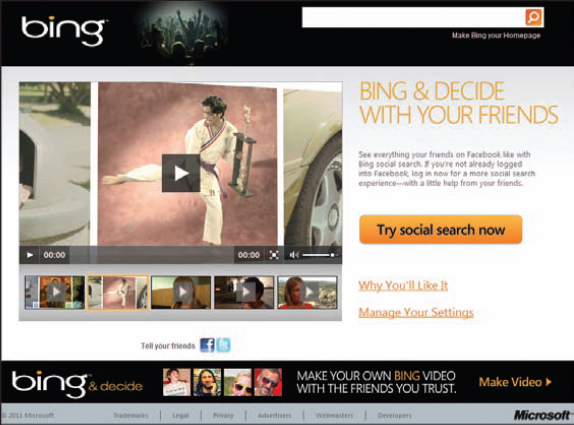
FIGURE 10-23: Bing's new Social Search engine from Microsoft juxtaposes your friends' opinions and search results
By now, you've seen several ways in which to maximize your brand presence via viral marketing. Hopefully, your app (with or without the support of a larger brand) can take advantage of some of these recommendations (as well as some of your own) and see significant gains in overall awareness, along with a diverse set of channels in which people can find it.
